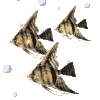|
Scientific Name: Carassius auratus
Common Name: Comet Goldfish
Synonyms: China: Chin-yii. Japan: Kingyo
Genus:Carassius
Order:Cypriniformes
Class:Actinopterygii
Family: Cyprinidae
Subfamily: C. a. auratus
Etymology:gilded in color
Origin: China
Distribution: Worldwide
Size: 6-8in
Diet: Omnivorous - will eat almost everything, and enjoys plants and vegetables. Peas once a week is reccommended, as
they can be a little prone to constipation.
Lifespan: Up to 30 years - 6-8 on average.
Sexual dimorphism: Males usually smaller and more slender than the female, especially in breeding season as she fills
with eggs. The male will develop white breeding tubercles on its gill covers and head.
Minimum Tank Size: 15G
Females:males ratio: 5:1 is reccommended.
Tank Setup: Comets and Shubunkins need tanks with lids - as they like to jump! They like elodea best - as it's tasty,
fast growing, and easily replaced. They aren't fussy about ornaments, as long as they have no sharp edges.
Min / Max number in tank: Goldies are messy fish, so stick to the one inch of fish per gallon where possible.
Water parameters:
* Water Type: Freshwater
* Temp: 16-28°C (However comets do better in the cooler range. Fancy should never be cooler than room temp.)
* Hardness: 5 - 30dh
* pH: 6.5 - 7.5
Temperament: Easygoing, intelligent fish. Occasionally school, but are happy enough on their own. Can pester larger, gentle
fish, but don't tend to harm them.
Compatibility: Social animals, but will eat any fish small enough to fit in their mouths, as well as fry.
Breeding: The tank needs to be cooled to about 11°C, and then raised back up slowly to copy the spring season.
High protein foods will encourage them to begin spawning, and then the male will begin to chase the female for a few days
as their colours strengthen.
He will then push her into the plants, and they will wriggle together, dropping sticky eggs in threads.
They may lay as many as 10,000 eggs in 2 hours - and then begin to eat as many as they can find - so you will need to
remove the parents.
Eggs hatch in 4-5 days at 19°C, fry will be very dark coloured, and can be put with the adults after they reach at least
an inch long. Feed them as you would any other fry, on infusoria, then baby brineshrimp.
They are quite intelligent, and like to handfeed when they recognise the owner. When they've figured out handfeeding,
they will come to see what you are doing every time you put your hand in the tank - don't worry, they don't bite! (Too much!)
|

